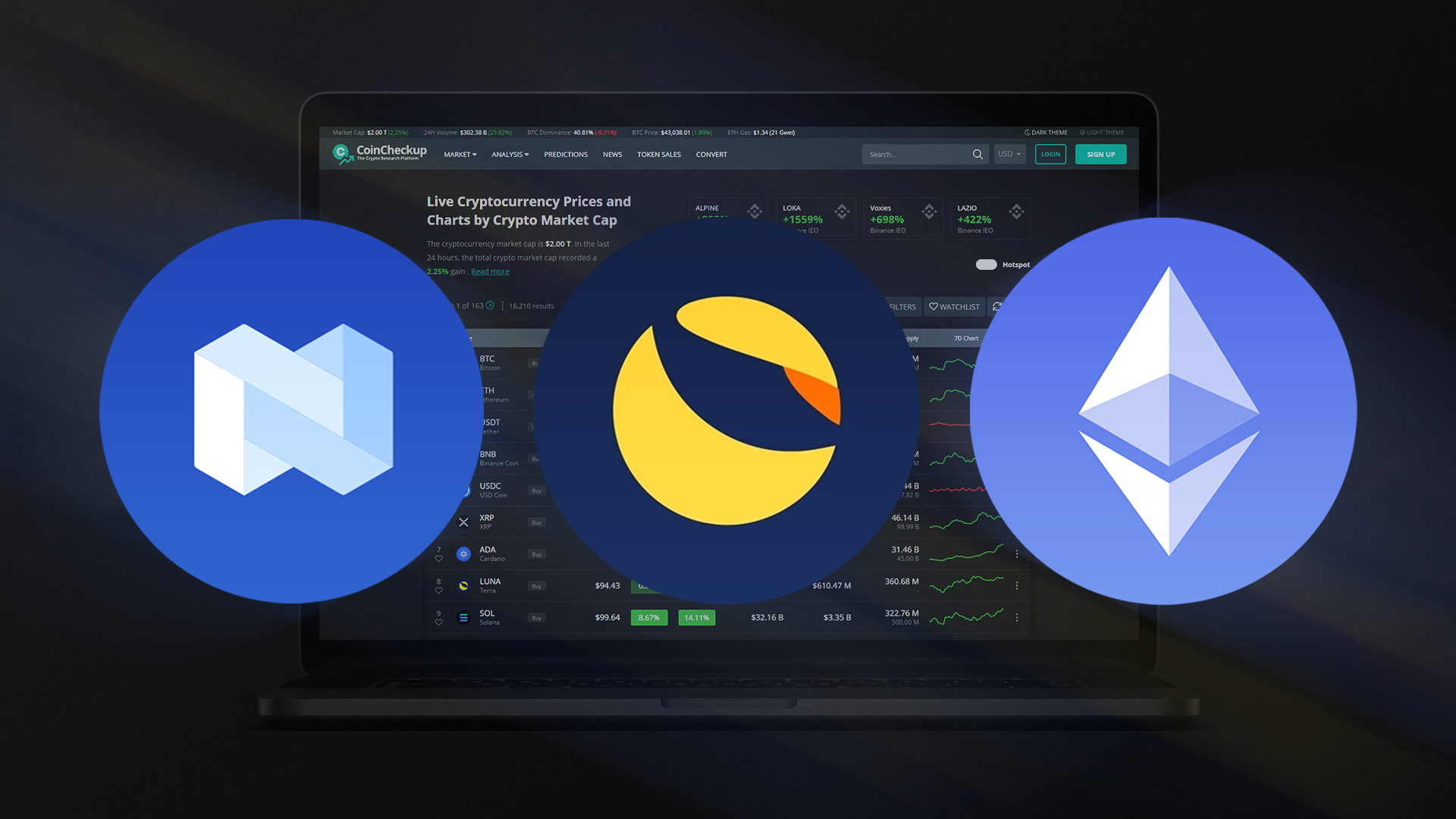
After a few weeks of rather sideways trading, the cryptocurrency market has demonstrated a slight growth in valuation last week. While the total market capitalizations accounted for almost exactly $1 trillion last Sunday, the total valuation of all cryptocurrencies combined stood at almost $1.1 trillion at the beginning of Week 37. Nevertheless, some cryptos exceeded the market average growth of 10%. These include LUNA, LUNC, RVN, HNT and ATOM to mention just a couple currencies that have demonstrated the fastest growth in terms of relative price change throughout last week. To find out which coins could end up dominating the list of gainers for this week, continue reading this article.

3. Nexo (NEXO)
Nexo started out as a centralized lending and borrowing platform that allows people to take out stablecoin loans as well as fiat cash loans by using their crypto holdings as collateral. The platform also offers high yield interest accounts to its users, which acts as the source of liquidity for the platform’s loans. Through its history Nexo kept expanding its range of services, which now also include a cryptocurrency exchange with over 300 trading pairs and a Nexo Card, which allows you to spend your crypto without selling it. Nexo Token is the native cryptocurrency of the ecosystem and the basis of the Nexo loyalty program. Users who hold a larger percentage of their portfolio in NEXO can enjoy reduced trading fees as well as higher interest rates when lending and lower interest rates when borrowing. In addition, Nexo has also committed to buy and burning $50 million worth of Nexo Tokens as part of its most recent Buyback Program.
Nexo introduces Nexo Pro – a centralized cryptocurrency exchange packed with features and liquidity
Last week popular crypto lender Nexo introduced its advanced trading platform called Nexo Pro, which supports limit and market orders, margin trading with up to x5 leverage, as well as Take Profit and Stop Loss functionalities and is fully integrated with other Nexo’s services. In addition, Nexo Pro aggregates liquidity from more than 10 liquidity providers, allowing the platform to offer traders one the most favourable price available on connected markets, one of the tightest spreads and a near-zero slippage. Furthermore, Nexo Pro also offers perpetul futures contracts and API gateways to cater the needs of more advanced crypto traders. To allow users to incur even lower costs while testing out the platform, Nexo has halved the trading fees utnil November 30.
Looking at other developments in the crypto lending sector we can see that Nexo is one of the few centralized crypto lenders that has been left relatively unscathed by the bear market. Two of the platform’s major competitors – Celsius and Voyager, recently filed for bankruptcy, while others such as BlockFi are reportedly struggling to keep their businesses alive. Nexo, on the other hand, is holding talks with another struggling crypto lender competitor Vauld.
According to a Vauld spokesman, talks with Nexo are still ongoing. Sources close to the deal are saying that Nexo is conducting its due diligence in relation to the potential acquisition and that the Nexo’s exclusivity period has been extended to October 6. If Nexo ends up buying Vauld, Nexo will restructure Vauld’s operations and focus on growing its market share in the Southeast Asia and India. This could consequently lead to the appreciation of NEXO, which is currently changing hands at a price of $0.98 per token.

2. Terra Classic (LUNC)
Terra blockchain was the basis of the same-named algorithmically governed stablecoin platform that was built using Cosmos technology. The blockchain, which utilized a proof-of-Stake (PoS) consensus mechanism, was developed by a South Korea-based company named Terraform Labs. LUNA, once the reserve currency of the Terra platform started losing its dollar peg on May 10, 2022, which pushed the entire Terra ecosystem into a downward spiral that ended with the halt of the Terra blockchain just 3 days later. Consequently, both UST and LUNA tokens lost almost all their value and became practically worthless overnight. Once Terra blockchain relaunched, the old, failed blockchain was renamed to Terra Classic, and ex-LUNA tokens got a new ticker: LUNC. While the Terra Classic blockchain is operational again, its market cap and activity are still far from the ones seen in the months preceding the collapse. However, the Terra Classic ecosystem is growing again and LUNC is currently 31st largest cryptocurrency by market cap.
The renaissance of LUNC: the token is up by more than 500% in last 3 months
After the collapse of the Terra Classic ecosystem in May, and the subsequent 99.99% drop in the price of LUNC, the token has formed a massive rally over the past three months, gaining more than 500% in the time period. Furthermore, the LUNC price is up by almost 20,000% from its lowest valuation in May 2022. The uptrend could be attributed to the series of upgrades made to the Terra Classic protocol including the recent activation of LUNC staking. The protocol promises stakers whopping (and likely unsustainable) APYs of up to 37.8%, but the majority of investors seem to have learned a lesson this spring as only around 9% of circulating LUNC tokens are currently staked. In addition, a large part of the LUNC appreciation can be explained by the 1.2% burn tax that came into effect on September 1. Every transaction, even wallet and smart contract interactions within the LUNC ecosystem are subjected to the 1.2% tax, whose aim is to reduce the enormous supply of LUNC that was minted during the ecosystem collapse in May and make LUNC a deflationary asset. Last but not least, the Terra governance has recently opened the LUNA airdrop claim portal.
LUNC or other Terra-based asset holders “who either did not receive the correct allocation of LUNA at Genesis due to technical constraints or issues associated with indexing” are now able to claim their rightful share of LUNA tokens. The team will airdrop more than 19 million LUNA tokens, but eligible users need to place a claim through the claim interface that will remain open up until October 4. Some of the liquidity from this airdrop could eventually be chanelled into LUNC providing extra fuel for the already strong rally. Nevertheless, the effects of this will be all but sudden as all airdropped LUNA will be vested over the period of 2 years to avoid the instability in market liquidity.

1. Ethereum (ETH)
Ethereum is an open source blockchain that pioneered smart contract functionality in 2015. The decentralized network operates in a fast, immutable, and trustless manner. Ether (ETH), which is currently the second-largest cryptocurrency by market capitalization, is Ethereum’s native asset. Although it can also be used as a medium for the transfer of value between different Ethereum addresses, it is more commonly used to execute various smart contracts. The Ethereum blockchain has enabled several blockchain-powered innovations, including ICOs, DeFi, NFTs, and DAOs. The Ethereum blockchain also hosts countless ERC20 tokens with different utilities – these include Exchange tokens (OKB, HT, UNI), DeFi tokens (LINK, MKR, COMP, SNX, etc.) and several stablecoins such as USDC, DAI, TUSD, and USDT. As The Merge is right behind the corner, Ethereum is closer to ending the process of transition from Proof-of-Work to a Proof-of-Stake blockchain than it has ever been before.
The Merge is expected to execute between September 13 and September 15
Thanks to Bellatrix, the last Ethereum mainnet upgrade that was successfully deployed on September 6, everything is prepared for the deployment of arguably the single most important update in the history of Ethereum.
After several months of Merge-related hype, the final stage of Ethereum’s transition from Proof-of-Work to Proof-of-Stake will all but certainly take place next week. According to Ethereum co-founder Vitalik Buterin, the Merge mechanism will trigger once the so-called Terminal Total Difficulty (TTD) reaches 58750000000000000000000, which he expects to happen “around September 13 to September 15”. TTD therefore represents the total difficulty required for the final block that will be mined using PoW consensus. While a lot of things will change after the Merge, some metrics such as the network throughput and fee prices will take a bit longer to be affected. You can read more about the Merge and Top 5 Myths about it in one of our recently published articles. The hype before the Merge can also be felt on the markets, as ETH gained almost 14% against USD and is currently changing hands at the price of $1,790. Should the Merge execution go through smoothly a short-term rally is very likely to accompany the event.



